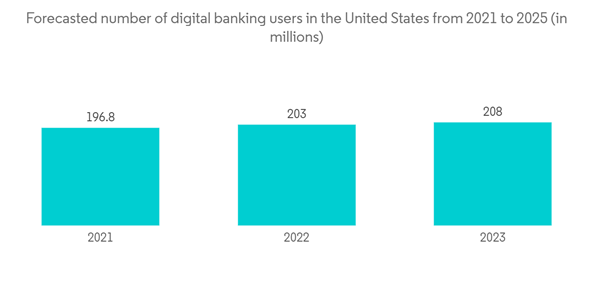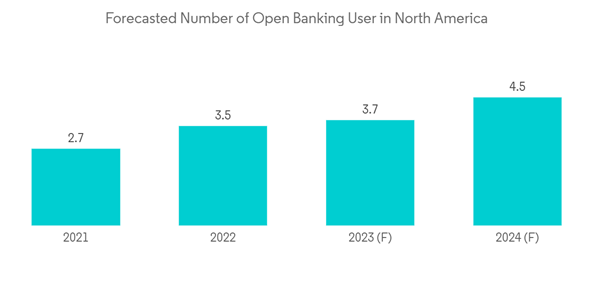The primary source of revenue for most banks is business lending, which typically accounts for 60% of their revenue in addition to their absolute loan portfolio, particularly for provincial and smaller banks. Several leading banks in the United States are investing in innovation as a key factor for their future growth, in some form or another. As for customer portals and applications, in the current computerized banking landscape, IT drives are having similar effects in the back-office as they do in client-facing channels. Corporate and commercial banking revenue in the United States has increased at a rate that is twice the rate of economic growth.
The commercial banking market in the US is expected to see an increase in partnerships between FinTech firms and digital lending companies for payment collections. Open banking is also expected to reshape the competition in the market in the next few years. Banks that invest in capabilities will position themselves well to remain strong consumer brands.
However, loan growth has increased in the last few months, with annual growth slowing from nearly double digits late the previous year to around 9%, indicating tighter conditions are starting to dampen bank credit growth. Over the last three years, household budgets have benefitted from excess savings and debt relief from the COVID-19 pandemic, but that is about to change.
The coronavirus pandemic has had a significant impact on financial inclusion, leading to a surge in digital payments at a time when formal financial services are expanding globally.
US Commercial Banking Market Trends
Increased Digitalization in the Commercial Banking
Digital transformation is well underway in commercial banking, and IT leaders in the sector anticipate that the strategic value of digital innovation will grow significantly over the next couple of years. Although cash digitization and digital financial services have evolved to meet consumer needs, it can be difficult for some providers to keep up with the fluidity of digital commerce and fast-paced innovation.For instance, Citi has unveiled the launch of CitiDirect®, a new digital platform designed to meet the needs of its commercial banking clients. This initiative is part of a larger strategic investment strategy to meet the increasing global demands of these customers by providing a unified digital platform. The platform is currently available in the United States, with more than two-thirds of the company's U.S client base utilizing it, and the company plans to expand its reach to other markets in Asia in the latter part of 2023, including Hong Kong and Singapore, as well as the United Kingdom.
Use of Open Banking is gradually increasing in United States.
Open banking gives consumers more options and a comprehensive range to help them achieve financial wellness. It gives them better access to faster and more personalized digital platforms that help them monitor their spending, stay on their budget, and reach their financial goals. The timing of open banking is critical as we head into 2022 with increased uncertainty about the economy's future.Consumer demand for seamlessly connected services has led to the development of a state-of-the-art, open banking environment in the U.S. Open banking allows financial service providers to leverage consumer-consented financial data to provide their customers with more tailored, flexible, and creative experiences. This value proposition resonates strongly with consumers in the United States – 87% of U.S. consumers use open banking. Consumers commonly connect their bank, investment, and loan accounts to multiple financial applications that provide payment, personal finance, BNPL, and more.
Bank apps dominate customer financial services interactions, with 76% of consumers connecting their financial accounts to an app for sending or receiving payments, second only to payment applications at 68%.
US Commercial Banking Industry Overview
The US Commercial Banking Market is highly competitive, with major international players. The US commercial banking market presents opportunities for growth during the forecast period, especially for the FinTech startups collaborating with these prominent players, which is expected to drive market competition further. With a few players holding a significant share, the US commercial banking market has an observable level of consolidation and has the highest market share in a decade. The major players dominating the market are JPMorgan Chase & Co., Bank of America Corp., Citigroup Inc., Wells Fargo & Co., and Goldman Sachs Group Inc..
Additional Benefits:
- The market estimate (ME) sheet in Excel format
- 3 months of analyst support
This product will be delivered within 2 business days.
Table of Contents
Companies Mentioned (Partial List)
A selection of companies mentioned in this report includes, but is not limited to:
- JP Morgan
- Bank of America
- Wells Fargo
- Citibank
- Goldman Sachs Group Inc
- Morgan Stanley
- US Bancorp
- PNC Financial Services Group Inc
- Capital One Financial Corp










